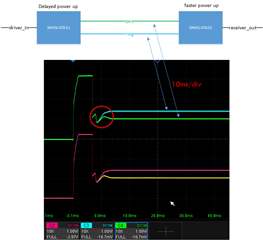Other Parts Discussed in Thread: SN65LVDS31,
Hello dear TI-support-team,
i have a LVDS-interface with a SN65LVDS31 driver and SN65LVDS32 receiver. I attached a picture of the block diagram and the oscilloscope measurement during power-up. The receiver turns on faster than the driver, so the receiver goes into fail-safe first. After that, we have this transition region (red circle) where the differential voltage is smaller than 100mV. Then the driver is activated and it drives the lines to its specified levels.
I have no possibility to measure the receiver out. Is it possible, that the receiver emits pulses on "receiver_out" because of the undefined state (red circle). In Datasheet section 10.4 (SN65LVDS32) it says: OUTPUT is "?" when differential voltage is between -100mV and 100mV.
Thank you
Best regards,
lyto


